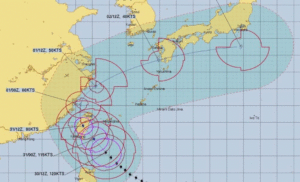MANILA/TAIPEI/SEOUL/TOKYO – As super typhoon “Kong-rey” continues its path through East Asia, it has left a trail of destruction in the Philippines, Taiwan, and South Korea, prompting urgent preparations in Japan for the storm’s arrival.
In the Philippines, “Kong-rey” unleashed fierce winds and torrential rain, resulting in significant flooding and landslides across multiple provinces. Communities are grappling with the aftermath, as emergency services work to rescue stranded residents and assess the extensive damage to homes and infrastructure.
Taiwan was not spared from the storm’s wrath, with reports indicating severe damage to buildings and transportation systems. The heavy rains led to widespread flooding, displacing thousands and overwhelming emergency response teams. The nation is currently in recovery mode, addressing urgent needs while bracing for the storm’s ongoing effects.
South Korea has also felt the impact, particularly on Jeju Island, where record-breaking rainfall has been recorded since December 1. According to Yonhap News Agency, the island has experienced the highest daily rainfall in November in the past century, causing flooding and disrupting daily life for residents and tourists alike.
The typhoon also struck the east coast of China, causing heavy rains and storms in the city of Shanghai.
With “Kong-rey” now heading toward Japan, authorities are taking decisive action. In Matsuyama, a southern port city, 190,000 residents have been ordered to evacuate as the government declares the highest alert level. The Japanese Meteorological Agency (JMA) has warned of heavy rain and thunderstorms, urging citizens to be vigilant against the dangers of landslides, flooding, and overflowing rivers.
Local governments are mobilizing resources and setting up emergency shelters to accommodate evacuees. Residents are encouraged to prepare emergency kits and stay informed through official channels as the storm approaches. (zai)
Map: Source: Joint Typhoon Warning Center, 2024

